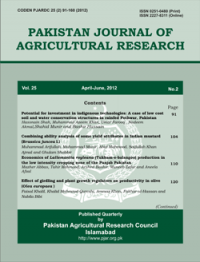GROWTH, YIELD AND NUTRITIVE VALUE OF NEW INTRODUCED BRACHIARIA SPECIES AND LEGUME HERBS AS RUMINANT FEED IN CENTRAL SULAWESI, INDONESIA
Mustaring,* I. Subagyo,** Soebarinoto** and Marsetyo*
ABSTRACT
Two simultaneous experiments were done to compare the growth, yield and nutritive value of grasses namely Brachiaria brizantha, B. mulato, and B. mutica and five legume herbs such as Clitoria ternatea, Dolichos lablab, Macroptilium bracteatum, Centrosema pascuorum and Centrosema pascuorum in Central Sulawesi, Indonesia using completely randomised block design. Each species was planted on 2.5m x 3m plot, and repeated 6 and 4 times in experiment 1 and 2, respectively. Parameters measured include plant height, tillage number, dry matter (DM) yield, in vitro digestibility and nutrient contents. Plant height and tillage number were monitored at week 4, 6 and 8 then harvested at week 8. Results revealed that the Brachiaria mutica (8 weeks old) had highest plant height (207 cm), but lowest tillage number (64), crude protein (CP) content (8.64%), in vitro organic matter (OM) digestibility (47.36%) On the other hand, B. mulato had highest tillage number (117) and DM yield (0.79 kg -2 DMm ). Legume herb species affected significantly (P<0.05) plant height, yield, in vitro digestibility. At 8 weeks of age Dolichos lablab showed the -2 highest plant height (189 cm), DM yield (0.45 kg DM m ) and in vitro OM digestibility (71.12%). The nutrient contents were not significantly affected (P>0.05) by legume herb species. In short B. mulato and Dolichos lablab showed the highest growth, DM yield and in vitro digestibility, therefore both forages are potentially to be scaled up in broader tropical region.
To share on other social networks, click on any share button. What are these?







